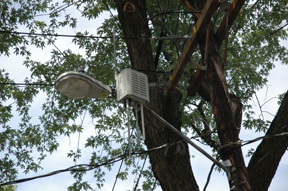|
Internationally the application for wireless mesh
networks has taken off. There is a real need to provide Internet and
other network services at speeds greater than 128 or 256k.
Service
providers, entreprenuers/investors and governments are testing and
implementing wireess mesh networks worldwide and the audience is
growing. Countries including Kenya, Africa, India, Greece, Finland,
Belgium, UK and others have announced their deployments. Some larger
than others. Some deploymens are hundeds of square-mile's and the
largest mesh network deployments in the world, while others are more
strategic and related to public safety, railway, surveillance, security
and sensor technologies, corporate communications, military etc.
Networks such as this are not just providing Internet or email access,
but making use of high density data applications, voice communications
and streaming video as well.
As these
networks grow and users come online, thousands, if not millions, are
being served and a multi-radio (three radios or more) technology is
required to provide the performance and scability for such networks.
 Capable
of handling the challenges of mountainous terrain, deep basins, large
valleys and dense folliage where most single- and dual-radio solutions
fail to provide acceptable coverage and performance, not to mention
real-time services like wireless VoIP (wVoIP), Strix wireless mesh
network system dedicates radios for each separate function of the mesh
(client access, backhaul ingress, and backhaul egress). By engaging the
advanced algorithm characteristics and high performanc of Strix
wireless system, integrators are able to eliminate many of the
challenges commonly associated with other systems. Capable
of handling the challenges of mountainous terrain, deep basins, large
valleys and dense folliage where most single- and dual-radio solutions
fail to provide acceptable coverage and performance, not to mention
real-time services like wireless VoIP (wVoIP), Strix wireless mesh
network system dedicates radios for each separate function of the mesh
(client access, backhaul ingress, and backhaul egress). By engaging the
advanced algorithm characteristics and high performanc of Strix
wireless system, integrators are able to eliminate many of the
challenges commonly associated with other systems.
Strix’s Access/One solutions employ a unique modular, multi-radio,
multi-channel, and multi-RF wireless mesh architecture that provides
the high throughput and low latency needed to support wireless voice,
video, and data applications today. This modular architecture is fully
flexible and scalable, allowing a countries network to grow simply and
affordably in the future. Strix architecture already provides
mechanisms to support QoS, solving problems such as bandwidth
degradation, network latency, and application priority contention.
Because Strix networks operate at 2.4 GHz, 5 GHz unlicensed and 4.9 GHz
licensed spectra on multiple channels of each spectra simultaneously,
Strix can separate client access from the mesh backbone, enabling the
system to dynamically optimize data paths, circumnavigate network
congestion and interference, and adjust in real time to avoid network
failure.
In one country what began as an
attempt to get more computers into schools per requirement of the
United Nations. The network is revolutionary, not simply because it is
considered the largest hotspot in the world, but because of its impact
on the economy and culture of the country it connects.
The project began three years ago, as part of USAID's e-Schools Project.
Initially, 460 primary and secondary schools in the country were to
receive a total of 5300 computers that had been. To accommodate the new
computers, labs were built in each of the schools. Once the computers
had arrived and the labs were built, however, the problem of getting
online presented a daunting challenge.
While
the original goal was only to deliver Internet connectivity to the
schools would have been a failure in part due to the monopoly held by
one provider. Basic Internet service was costing subscribers 120 euro
per month. The answer was to start, not by building towers, but by
changing the laws that governed the telecom business in the country.
Once
the laws were changed it allowed competition in the country and Strix
Systems was the wireless mesh network manufacture to win the project.
The first phase of the project was installed and operational within
four months and covered 95% of the country.
By
may 2006, a survey was taken and found that Internet penetration rate
went from 4% to 14% home use. Interestingly, all internet providers in
the country increased business as the previously expensive internet
services now became more cost effectively and in-line with what people
could afford and with increased subscribers the current 10GB network
access for the country is now not only more cost effective, but more
importantly is enabling greater education resources and improving will
continue to create more business opportunities. |